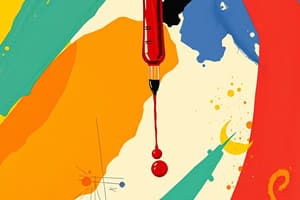Podcast
Questions and Answers
What is the additive used in the Sterile Yellow tube?
What is the additive used in the Sterile Yellow tube?
- Lithium Heparin
- Sodium Citrate
- Potassium EDTA
- SPS (correct)
Which tests are commonly associated with the Light Blue tube?
Which tests are commonly associated with the Light Blue tube?
- Blood Cultures
- Hormones
- D-Dimer (correct)
- CBC
What is the specimen type for the Red Glass tube?
What is the specimen type for the Red Glass tube?
- Whole Blood
- Whole Blood/Plasma
- Serum (correct)
- Plasma
Which additive is found in the Green tube?
Which additive is found in the Green tube?
What is the common test for the Lavender tube?
What is the common test for the Lavender tube?
Which specimen type is associated with the Gray tube?
Which specimen type is associated with the Gray tube?
List the 7 parts of the CBC.
List the 7 parts of the CBC.
What is the first specimen to draw during a capillary puncture?
What is the first specimen to draw during a capillary puncture?
Flashcards are hidden until you start studying
Study Notes
Order of Draw Phlebotomy
- The order of draw is essential to prevent cross-contamination of additives.
- Correct order ensures accurate test results.
Sterile Yellow
- Additive: SPS (Sodium Polyanethol Sulfonate)
- Type: Anticoagulant
- Specimen: Whole Blood
- Common in microbiology for blood cultures.
Light Blue
- Additive: Sodium Citrate
- Type: Anticoagulant
- Specimen: Whole Blood / Plasma
- Used in coagulation tests like D-Dimer and PTT.
Red Glass
- Additive: None
- Type: N/A
- Specimen: Serum
- Frequently utilized for chemistry and immunology, covering hormones and lipids.
Red Plastic
- Additive: Silica
- Type: Clot Activator
- Specimen: Serum
- Commonly used for proteins and enzymes tests in chemistry and immunology.
Gold / SST
- Additive: Silica & Thixotropic Gel
- Type: Clot activator & Physical Barrier
- Specimen: Serum
- Suitable for wide-ranging tests, including carbohydrates and vitamins.
Green
- Additive: Lithium Heparin or Sodium Heparin
- Type: Anticoagulant
- Specimen: Whole Blood/Plasma
- Often used for stat electrolytes, troponin, and bilirubin tests.
Lavender
- Additive: Potassium EDTA
- Type: Anticoagulant
- Specimen: Whole Blood/Plasma
- Essential for hematology tests like CBC and reticulocyte count.
Gray
- Additive: Potassium Oxalate & Sodium Fluoride
- Type: Anticoagulant & Antiglycolytic Agent
- Specimen: Whole Blood/Plasma
- Critical for alcohol testing (BAC & Ethanol).
Parts of the CBC
- Key components include RBCs, WBCs, Platelets, Differential Count, Indices, Hemoglobin, and Hematocrit.
- Provides comprehensive insight into blood health.
Order Of Draw for Capillary Puncture
- 1st: Capillary Blood Gases (CBG's)
- 2nd: EDTA Specimens
- 3rd: Other Additives (Heparin and Oxalate)
- 4th: Serum Specimens
- Ensures minimized contamination and accurate test outcomes.
Studying That Suits You
Use AI to generate personalized quizzes and flashcards to suit your learning preferences.




